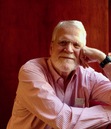Mark Scott Smith's Blog: Enemy in the Mirror, page 78
June 25, 2018
Truman Doctrine
The purpose of the Truman Doctrine delineated in 1947 was to counter geopolitical expansion of the Soviet Union. Initially, in place of direct military action, the U.S. Congress appropriated financial aid to support the economies and militaries of Greece and Turkey. Eventually, the Truman Doctrine implied American support for all nations threatened by communism.
THE NEW WORLD ORDER

Published in Philadelphia in early 1942, this Post-War New World Map, created by Maurice Gomberg, proposes how the world might be re-arranged after an Allied victory over Axis forces. (www.globalresearch.ca)
________________
Here is an interesting summary of the new world order from an opinion piece entitled The Trump Doctrine Is Winning and the World Is Losing by Kori Schake in the New York Times on June 15, 2018.
“Let’s review what, exactly, that order is. Beginning in the wreckage of World War II, America established a set of global norms that solidified its position atop a rules-based international system. These included promoting democracy, making enduring commitments to countries that share its values, protecting allies, advancing free trade and building institutions and patterns of behavior that legitimize American power by giving less powerful countries a say.”
(Unfortunately, these goals became so ideologically-oriented that America intervened in the political affairs of other nations and often supported repressive dictatorships as long as they were anti-Communist.)
The post Truman Doctrine appeared first on Enemy in the Mirror.
June 21, 2018
WWII U-Boat Ace Dies at 105
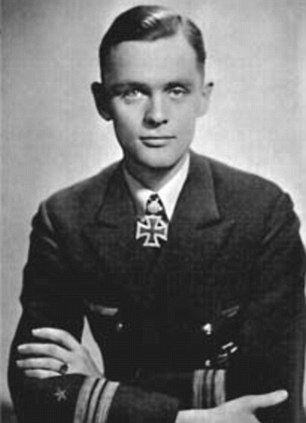
U-Boat ace Reinhard Hardegen died this week at age 105. Although America’s WWII enemy, Hardegen appears to have been an honorable warrior, revered by many today who are fascinated by the mystique of U-Boat warfare.
____________________
Captain of the infamous U-123 in the Battle of the Atlantic, Reinhard Hardegen was the role model for the fictitious U-Boat captain Rainer Hartmann in my book The Osprey and the Sea Wolf ~ The Battle of the Atlantic 1942 to be released soon.
Here is an excerpt from my book about a refueling encounter at sea with a Milchkuh (milk cow) submarine:
Rainer smiled as he surveyed the approaching submarine tanker, now bathed in pale moonlight. Although much wider, the Milchkuh resembled his own boat with one major difference. The Milchkuh had neither torpedoes nor deck cannon. Designed only to resupply other U-Boats and defend itself, the Milchkuh had no offensive role. Despite two formidable antiaircraft Flak cannons, the Milchkuh was especially vulnerable to air attack during refueling operations. Disconnecting equipment and refueling hoses took time, and the bulky submarine tanker was a slow diver. The refueling process was also dangerous for Rainer, since the standing order was no diving before the Milchkuh had safely submerged.
Soon, the U-023 and the Milchkuh were running parallel courses, at three knots with a distance between them of 25 meters. The commander of the Milchkuh called out to Rainer from his bridge with a megaphone. “Guten Abend, Herr Kommandant. Fertig? Are you ready?”
“Fertig!” Rainer yelled back, touching the brim of his cap with a brisk salute.
What followed was like a slow-motion ballet between two whales far out to sea. With a signal from Rainer, Wolf’s crew on the aft deck began hurling thin lines, weighted at the tips, toward the crew of the Milchkuh. At the same time, Milchkuh crewmen threw lines toward the U-023. After a brief, friendly competition, a cheer arose from Wolf’s crew as a line they’d hurled was secured by Milchkuh deckhands. Eight seamen on the aft deck of the U-023 tended a highline between the two U-Boats, adjusting its tension as the U-Boat commanders maneuvered to maintain a safe distance between each other.
On the Milchkuh, crewmen packed rubber rafts with food and water and general supplies. The rafts were then attached to pulleys on the highline and hauled in by crew of the U-023. The transfer of seven-meter long torpedoes involved more elegant maneuvers. Four torpedoes were wrapped in life jackets and floated off the Milchkuh as the submarine submerged enough to flood the deck. The torpedoes were then pulled through the water to be corralled and stowed by the crew of the likewise flooded-down U-023….
________________
The post WWII U-Boat Ace Dies at 105 appeared first on Enemy in the Mirror.
June 18, 2018
Kalashnikov AK-47
Reliable in extreme conditions, simple to use and cheap to produce – the AK-47 assault rifle was designed by Mikhail Kalashnikov after WWII. The originalI AK-47 model has spawned a host of derivative assault rifles.

Mikhail Kalashnikov; Wikipedia

The AK-47 is reportedly the most widely spread weapon in the world, with 100 million Kalashnikov rifles currently in use.

ak-47-tattoo-outline-drawings_91638.jpg
It is believed that AK-47s have caused more deaths than artillery fire, airstrikes and rocket attacks combined. An estimated quarter of a million people are gunned down by bullets from Kalashnikovs every year.
There is disagreement regarding Kalashnikov’s personal feelings about his creation. One source claims he had no qualms – “I sleep well. It’s the politicians who are to blame for failing to come to an agreement and resorting to violence.” Another source states, in a letter written six months before his death Kalashnikov wrote: “I keep having the same unsolved question: if my rifle claimed people’s lives, then can it be that I… a Christian and an Orthodox believer, was to blame for their deaths?”
Russian AK-47, America’s new weapon of choice – 2012 video

This in-depth New York Times article is worth a read: How the AK-47 and AR-15 Evolved Into Rifles of Choice for Mass Shootings
The post Kalashnikov AK-47 appeared first on Enemy in the Mirror.
June 14, 2018
New Japanese Constitution
Based on American models, the Supreme Allied Commander General Douglas MacArthur directed an effective restoration of the industry and society of occupied Japan. The majority of the Japanese people apparently welcomed his progressive reforms.
Most important, after Japanese initial Japanese attempts were deemed too conservative, MacArthur and his staff essentially wrote a new Japanese constitution to replace the 1889 Meiji Constitution. In May 1947, Japan’s postwar constitution went into effect.
The constitution:
• created a parliamentary system of government
• granted universal suffrage
• reduced the Emperor’s power to a symbolic role
• stipulated a bill of rights
• abolished hereditary or honorary government positions
• prohibited the nation from declaring war
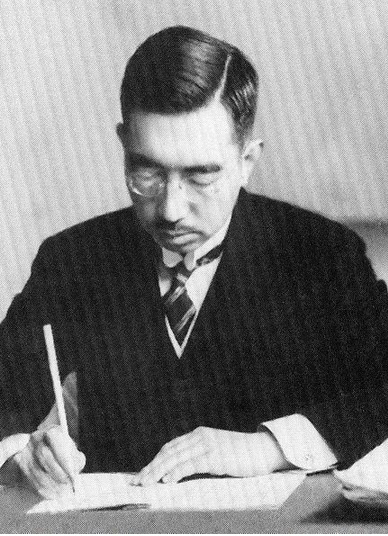
Article 4 of the 1947 Japanese constitution: The Emperor shall perform only such acts in matters of state as are provided for in this Constitution and he shall not have powers related to government

Although the national flag of Japan is officially called Nisshōki (日章旗, the “sun-mark flag”), it is more commonly known as Hi no maru (日の丸, the “circle of the sun”). The sun plays an important role in Japanese mythology as the Emperor was said to be the direct descendant of the sun goddess Amaterasu.
Since the end of WWII, the continued use of the circle of the sun flag and the national anthem Kimigayo has been contentious. Disputes have led to protests and lawsuits in Japan and the flag is not frequently displayed due to its association with ultranationalism, aggression and imperialism.
The post New Japanese Constitution appeared first on Enemy in the Mirror.
June 13, 2018
Enemy in the Mirror

Excerpts from the book:
Once the shoji screen was closed, Kiyoshi said in a low voice, “It’s about the piece I submitted to the Chūō Kōron.”
Fumiko took a deep breath. The Chūō Kōron was one of the few literary magazines that still dared to publish articles hinting at disagreement with official policy. Recently, government censors had confiscated several issues just as they’d arrived at news stands. They’d snipped out entire paragraphs and, preposterously, returned them for sale. Authors of the censored material would obviously come to the attention of the Tokkō.
Kiyoshi looked at her with an expression of fear and resignation. “I’m to report to the Tokkō tomorrow morning for questioning.”
The first few waves Helen encountered were almost depleted into running white water and she crossed them at half throttle. Increasing to a steady three quarters throttle, she timed her run to meet the first large wave of the next set straight on, right after it had fallen to bow height. The wave rumbled in, cresting at six feet, and curled. Just as it crashed into white foam, Helen increased power and sliced the bow into the cold, green body of water. The boat lifted over the crest and slid down the backside into a trough pointing directly at the next oncoming wave.
The second wave, just as tall as the first, arrived faster than the ten-second prediction…
A little before midnight, the sound of an explosion jolted Nick out of deep sleep. Men were running outside the barracks as a bugle sounded the call to arms. “What’s going on?” Nick shouted at Jim.
“Don’t know,” Jim muttered, scrambling out of his bunk. “Sounded like a bomb.”
“Man your posts!” the Sergeant yelled through the barracks door. Someone snapped on the lights. Half-awake, Nick and the other soldiers stumbled about pulling on their clothes and hastily lacing up their boots.
There was a decrescendo whistle, silence, then a loud explosion somewhere south of the drill field. The sounds repeated at short intervals with no discernible pattern. Shells seemed to be landing close, but no obvious damage could be seen…
Ensign Isamu Takahashi covered his ears as the 127 mm gun on the aft deck fired at the dark shoreline. The cannon’s recoil sent a vibration all the way to the bridge of the huge submarine, and diesel fumes, mixed with cannon smoke, wafted through the air. Uncovering his ears, he listened to the distant whistling sound, saw the flash and, moments later, heard the explosion. Standing beside him, Commander Masao Tamami scrutinized the shoreline and ordered the I-25 to cruise slowly at a bearing of 290°, firing at two-minute intervals. Isamu pressed the communicator switch and relayed the orders to the control room.
Clouds of blue smoke drifted above the sand and the smell of diesel oil and creosote filled the air. Although they’d been through this before, every man on the beach was tense and anxious. Some prayed. Some clutched good luck charms. Nick shut his eyes briefly and tried to picture Ruth on a very different beach.
To avoid special attention from snipers, officers and medics wore no insignia. Several men had scrawled “Fight!” or “To hell with Tojo!” across the back of their field jackets. All eyes were on the young Lieutenant, waiting for the signal to attack.
The Lieutenant rose and pumped his M-1 in the air. He blew his whistle three times. “All right, men! Let’s give ‘em hell!”
Yesterday, on the overpass above the railroad station, Fumiko paused to greet Mr. Murakami, the station master who was standing at the railing. He acknowledged her greeting courteously, but, with a nod, quickly brought her attention to a somber ceremony occurring on the platform below. A row of soldiers, shrouded in a cloud of gray steam, stood at attention as an officer unloaded small white boxes, one by one, from a freight car. Cradling each box in his arms, he strode solemnly across the platform to a row of stoic middle-aged women. He bowed and called out a name. A woman stepped forward, bowed and accepted the box. The officer bowed again and returned to the railroad car for the next box.
“Where do you think the decisive battle will be?” His father asked Tadashi.
“The SHO operation? No one knows, Father. Some say the Ryukyu Islands or Formosa. I think it’ll be the Philippines. We’ve been making some special preparations I want to talk to you about.” He glanced briefly at his sister and mother before continuing. “Our conventional tactics can’t win against superior numbers and equipment. It’s time for a significant change.” He paused for a moment, looking directly at his father for assistance.
Mr. Suzuki cleared his throat and glanced at his wife. She rose immediately. “Excuse me. Fumiko and I must prepare dinner.”
Fumiko rose quickly with her mother, bowed and stepped out of the room, closing the panel behind them. As they headed toward the kitchen, she heard Tadashi speaking in a low tone.
“Father, I’m proud to tell you I’ve been selected for a new special attack force.”
Meticulously, Dave sutured the lacerated brachial artery and debrided the avulsed muscular tissue. Then, with traction on the shoulder by the circulating nurse, he attempted to align the shattered humerus.
“Something’s wrong,” Helen said, raising her voice. “His color’s poor and pulse 160.”
“Respiration?” Dave asked.
Helen listened to both sides of the chest. “Moving air OK on the right. Hardly at all the left.”
“Damn! Pneumothorax. Give me the biggest needle you’ve got,” Dave said to the circulating nurse. “And a two-way stopcock with a 50 ml syringe.”
“Fighting the Japs isn’t like fighting normal human beings,” Johnny declared. “That’s what my teacher said. He says we’ll have to kill them all to win this war. Is that right, Nick?”
Ruth began to shush Johnny, but Nick waved her off.
“Well, Johnny” he said. “I don’t know if you can say they’re not normal human beings, but they’re different from us all right. We’re ready to die for our country if we have to, but that’s not our first choice. We’ll retreat when it looks like we’re going to lose a battle. The Japs don’t do that. They just dig in and fight to the death.” He sighed. “So, yeah, Johnny, many times you do have to kill them all.”
Miyoko took a piece of crumpled paper from her purse, straightened it and handed it to Fumiko. “I found this by the waterfront yesterday. I think it was dropped by an airplane that flew over last week. Is this picture real, Suzuki-sensei?”
Fumiko realized immediately that the photograph with snowcapped Mount Fuji in the background was an Allied propaganda leaflet. A kimono-clad woman with a child strapped to her back stood in a cherry orchard littered with the corpses of Japanese soldiers. …
Fumiko folded the pamphlet and collected her thoughts. What should she say? That this was a crude attempt by the enemy to elicit subversion? That there was absolutely no truth in it? How could she reconcile her patriotic duty with being a wise mentor for this child? She inhaled deeply and slowly released her breath.
Editorial Reviews of Enemy in the Mirror: Love and Fury in the Pacific War
The Daily Astorian
If you are looking for a book to chase away the winter blues but can’t decide on one genre, you are in luck. Mark Smith’s book, Enemy in the Mirror: Love and Fury in the Pacific War deftly combines drama, romance and action into one enjoyable read. The novel is set against a backdrop that ranges from recognizable North Oregon Coast locales to across the Pacific Ocean in Imperial Japan. History buffs will delight in the attention to period detail. Most importantly, this book serves as a historical lesson on the useless tragedy of war and its transformative effects on family life. Enemy in the Mirror intertwines the stories of ordinary people on two Pacific shores, one in coastal Japan and the Northwest coast, whose lives are irreversibly altered by World War II. As the reader switches between nations, cultures and characters, you get a complete understanding of the terrible complexities of war and its reach into lives with much commonality. Instead of resorting to melodramatic clichés, the book gently reminds readers of the horrors of war while presenting human faces of the conflict that shaped a generation.
The depth of Smith’s research is obvious, and he deftly takes readers on a tour of a world at war. His best attributes include vividly descriptive scenes, excellent portrayal of raw human emotion and dialogue that has the ring of authenticity representative of the period. Smith locates us in the thick of battle without pulling punches, something that is needed in the 21st century when so many people seem desensitized to violence. He also lets us see how lives of those who wait at home for their loved ones to return can resort to a daily struggle to retain sanity.
Enemy in the Mirror brings us many lessons in how fragile life can be and how important it is to give and receive love, even when the world seems to be falling to pieces around us. It is to the author’s credit that we come to see these lessons less as suffering than as the epiphany of grace. Because Smith has steeped his characters in such philosophical territory, the reader is eager to learn more of their interior struggles, doubts, and moments of grief or bliss. It is a reminder that not everything in life can be wrapped up in a tidy little package, especially during wartime. Life is messy and uncertain, and Smith’s protagonists portray that directly from the pages.
Writing historical fiction poses daunting challenges, as events must align themselves with the facts. This means that characters sometimes are restricted in their movements. This is not the case with Enemy in the Mirror, as Smith pushes his characters up against their historical backdrop and challenges readers to respond. The book leaves the reader with a sense of sadness about the futile, senseless tragedy of war, and the reader is fully invested in this as the story winds down. There is, however, also a sense hope for the future because of the courageous and unyielding optimism of those who survived. In that way, Smith’s book is a love letter to past generations and a peace accord to future ones.
WW2 CONNECTION
Mark Scott Smith has written a superbly well-crafted book in Enemy in the Mirror: Love and Fury in the Pacific War, his first published work and for that he should be commended. His writing style is a joy, his use of the English language a treat. Enemy in the Mirror tells how the Second World War affected the lives of its American and Japanese characters. Every emotion is experienced: excitement, joy, pain and agony. The battle scenes are particularly descriptive and bring to mind the full horrors of war. There is plenty to be learned from this novel for those with an interest in WW2 in the Pacific and American Pacific home front.
While reading the book, I googled several events mentioned–Mark Scott Smith has done his research. Novels written with WW2 as the backdrop often find it difficult to truly portray the style and sense of nationalism. Enemy in the Mirror manages this on two fronts. The author’s obvious knowledge of the Japanese culture floods onto the pages. The book left me with a sense of understanding for the normal Japanese youth starting adult life during this tumultuous period of world history. So many ordinary lives were touched by events in the Pacific and perhaps this was the first time I had given much thought to the Japanese who suffered so much without any say in the decision-making process of their country. Enemy in the Mirror doesn’t glorify war, it leaves you with a sense of loss and sadness for its characters. It also shows that both cultures suffered immeasurable pain-and-suffering.
This is a novel that I would recommend highly. An emotional roller coaster of a story built around actual events of World War II.
Author Reviews
Brian D. Ratty – Author of: Dutch Clarke: The War Years
Dr. Mark Scott Smith’s book, Enemy in the Mirror, is a story about the human tragedies of war, not an action thriller. The author artfully contrasts characters living on opposite shores of the Pacific Ocean during WWII. One family has deep roots on the Oregon North Coast, while another family lives in a port city on a northern island in Imperial Japan. The reader is rewarded with different points of view from both cultures. In the beginning the Japanese are victorious and confident, while the Americans taste the agony of defeat. But, after many far-flung bloody battles and much hardship at home, the fortunes of war change. Enemy in the Mirror is the heartfelt story of these changing times and the people who lived their lives with love, fear, hope and loss.
The author of this well researched historical fiction novel, has packed his story with many visual metaphors that help establish the life and times of his colorful characters. His storyline is engaging and well written, with descriptions and dialogs that are pleasing and believable. Enemy in the Mirror is a good read for those searching for a better understanding of these tragic times.
Bill Baynes – author of The Occupation of Joe
Vivid battle scenes on land and undersea, as well as sympathetic characters on both sides, highlight Enemy in the Mirror. Mark Scott Smith focuses on a Japanese submarine attack on the Oregon coast in 1942 and then broadens his scope to the entire Pacific War, revealing the terrible cost of the conflict to American and Japanese combatants and their families. Well-researched and rich in period detail, Smith delivers a thoughtful and enjoyable read
The post Enemy in the Mirror appeared first on Enemy in the Mirror.
June 11, 2018
TELEVISION
Television shows in 1947
Series
Debut
Ended
Picture Page (UK)
October 8, 1936
1939
1946
1952
Starlight (UK)
November 3, 1936
1939
1946
1949
For The Children (UK)
April 24, 1937
1939
July 7, 1946
1950
The Voice of Firestone Televues
1943
1947
1949
1963
The World in Your Home
1944
1948
Boxing From St. Nicholas Arena
1946
1948
You Be the Judge
1946
194?
See What You Know
January 1946
1949
Hour Glass
May 9, 1946
March 1947
Face to Face
June 9, 1946
January 26, 1947
Geographically Speaking
June 9, 1946
October 1947
Cash and Carry
June 20, 1946
July 1, 1947
Serving Through Science
August 15, 1946
1947
I Love to Eat
1946
1947
You Are an Artist
1946
1950
Gillette Cavalcade of Sports
November 8, 1946
June 24, 1960
Let’s Rhumba
1946
1947
Television Screen Magazine
1946
1949
Campus Hoopla
1946
1947
Swing Into Sports
1947
1949
Chicagoland Mystery Players
1947
July 23, 1950
The Jack Eigen Show
1947
1951
Small Fry Club
1947
1951
Juvenile Jury
1947
1954
The Swift Home Service Club
May 1947
?
Doorway to Fame
May 2, 1947
July 4, 1949
Kraft Television Theater
May 7, 1947
1958
King Cole’s Birthday Party
May 15, 1947
June 23, 1949
In the Kelvinator Kitchen
1947
1948
The Walter Compton News
June 16, 1947
January 1948
Major League Baseball on NBC
July 8, 1947
October 17, 2000
Musical Merry-Go-Round
1947
1949
Kukla, Fran and Ollie
October 13, 1947
1957
Meet the Press (longest running program with more than 4000 episodes)
1947
Still in broadcast
Pantomime Quiz
November 13, 1947
October 9, 1959
Mary Kay and Johnny
November 18, 1947
March 11, 1950
Charade Quiz
1947
1949
Television Playhouse
December 4, 1947
April 11, 1948
Americana
1947
1949
Howdy Doody
December 27, 1947
September 24, 1960
Kaleidoscope (UK)
November 2, 1946
1953
Pinwright’s Progress (UK)
November 29, 1946
May 16, 1947
Muffin the Mule (UK)
1946
1955
Paging You (UK)
1946
1948
Café Continental (UK)
1947
1953
Eye Witness
1947
1948
The post TELEVISION appeared first on Enemy in the Mirror.
June 7, 2018
Haiphong Incident
On November 23, 1946 the French navy bombarded the Vietnamese coastal city of Haiphong, killing 6,000 Vietnamese people overnight. The Haiphong shelling was the first in a series of armed clashes leading to the December Battle of Hanoi and the outbreak of the First Indochina War.
On December 19, 1946, 30,000 Viet Minh initiated their first large-scale attack on the French in the Battle of Hanoi. War had begun again in Viet Nam.
This (undated) pro-French propaganda film seems to capture the events of the times.
The post Haiphong Incident appeared first on Enemy in the Mirror.
June 6, 2018
Wolves at the Doorstep 1942
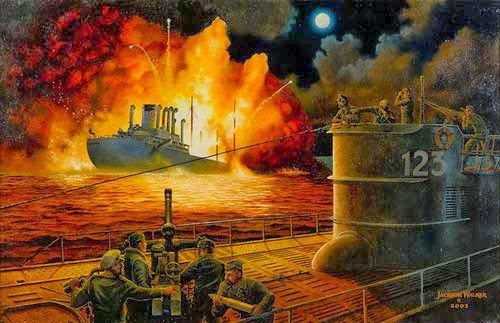
SS Gulfamerica – Navy League Jacksonville Florida Council
Somewhere between the attack on Pearl Harbor, the Bataan death march and the fierce fighting on Guadalcanal, many of us seem to have forgotten one of the most important American theaters in early WWII – The Battle of the Western Atlantic.
In 1942, German U-Boats sent over 300 merchant ships and 5000 seamen to the bottom of the ocean off the coast of North America. Fighting In the Western Atlantic, Gulf of Mexico and Caribbean Sea, Allied forces ultimately prevailed, thereby preserving the vital supply line of war materials to a besieged Great Britain.
“The only thing that ever really frightened me during the war was the U-boat peril.” – Winston Churchill: The Second World War, Volume 2, 1949.

In this history-inspired novel about 1942, a seasoned U-boat commander and a young Mexican-American B-25 pilot engage in a deadly dance of war at sea and struggle with issues of love, honor, betrayal and racism on their respective home fronts.
The Osprey and the Sea Wolf ~ The Battle of the Atlantic 1942 will be released on the 4th of July.
The post Wolves at the Doorstep 1942 appeared first on Enemy in the Mirror.
June 4, 2018
It’s A Wonderful Life
After a series of populist films in the 1930s (It Happened One Night, Mr. Deeds Goes to Town, Mr. Smith Goes to Washington, and You Can’t Take It With You), Frank Capra read a forgotten story entitled The Greatest Gift written by Philip Van Doren Stern and turned into the script for It’s A Wonderful Life. As the first production he made after returning from service in WWII, Capra intended the film to be a celebration of the lives and dreams of ordinary American citizens, who try to do their best for themselves and others.
Though it has become a quintessential American classic, It’s a Wonderful Life, starring James Stewart and Donna Reed, was not an immediate hit when first released in 1946. In fact, Capra lost $525,000 on the production. However, when the copyright expired and the film fell into the public domain, it was picked up by TV networks such as PBS and is now an enduring seasonal hit each year.
Perhaps not so humorous (although clearly ridiculous) at this early phase of the Cold War, a 1947 FBI memo noted the film showed “potential Communist infiltration of the film industry with its attempt to discredit bankers – a common trick used by Communists.”
Capra, a trained engineer and his special effects supervisor Russell Shearman engineered a new type of artificial snow for the film made of sugar, water and (fire extinguisher) Foamite. Up until that time, cornflakes painted white were the most common form of fake snow, but they were noisy.
Sources:
Roger Ebert – film review
Jennifer M. Wood – 25 Wonderful facts about It’s A Wonderful Life
The post It’s A Wonderful Life appeared first on Enemy in the Mirror.
May 31, 2018
Tsunami Japan
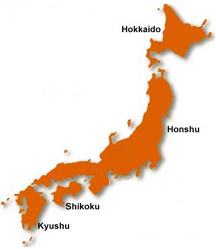
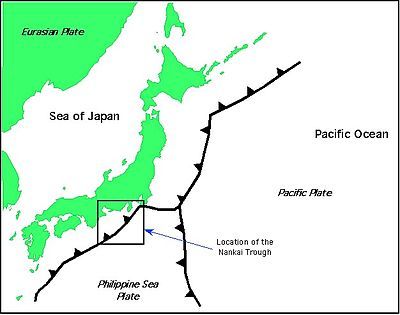
On December 21, 1946 an 8.1-.4 magnitude undersea earthquake initiated a powerful tsunami in the Nankai Trough off Japan’s largest island Honshū. When 20-foot waves hit shore, buildings were obliterated and ~2,000 ships were capsized. 60,000 square miles were flooded and 40,000 homes were completely destroyed. ~2,000 people were killed and half a million made homeless.

TBT’s Blog

Small town of Tanabe, Japan in the aftermath of an earthquake on Dec. 21, 1946. (AP Photo/U.S. Fifth Air force)û
________________________________
In measuring the impact of this disaster, it is important to recall that this huge tsunami occurred only a year after a devastating air raid campaign of incendiary bombing directed against Japanese civilians in the final stages of the Pacific War.


__________________________

Japan has such a large potential for earthquakes because the country sits on top of four tectonic plates.
The 2011 Tōhoku earthquake, also known as The Great East Japan Earthquake (東日本大震災), was the most powerful earthquake ever recorded in Japan (fourth most powerful in the world) since modern record-keeping began in 1900.

The post Tsunami Japan appeared first on Enemy in the Mirror.
Enemy in the Mirror
I began by posting events around the turn This website www.enemyinmirror.com explores the consciousness, diplomacy, emotion, prejudice and psychology of 20th Century America and her enemies in wartime.
I began by posting events around the turn of the 20th century as I was researching my first novel about the Pacific War. I continued through WWII for my second novel about the Battle of the Atlantic. Now I am beginning to look at the Cold War as I gather information for my next novel about the Korean War. ...more
- Mark Scott Smith's profile
- 7 followers


